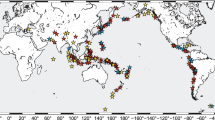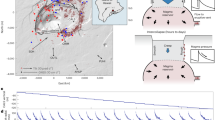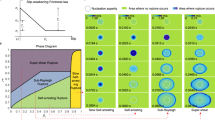Abstract
In the past decade there have been major advances in understanding the seismic cycle in terms of the recognition of characteristic patterns of seismicity over the entire tectonic loading cycle. The most distinctive types of patterns are seismic quiescences, of which three types can be recognized:post-seismic quiescence, which occurs in the region of the rupture zone of an earthquake and persists for a substantial fraction of the recurrence time following the earthquake,intermediate-term quiescences, which appear over a similar region and persist for several years prior to large plate-rupturing earthquakes, andshort-term quiescences, which are pronounced lulls in premonitory swarms that occur in the hypocentral region hours or days before an earthquake. Although the frequency with which intermediate-term and short-term quiescences precede earthquakes is not known, and the statistical significance of some of the former has been challenged, there is a need, if this phenomena is to be considered a possibly real precursor, to consider physical mechanisms that may be responsible for them.
The characteristic features of these quiescences are reviewed, and possible mechanisms for their cause are discussed. Post-seismic quiescence can be readily explained by any simple model of the tectonic loading cycle as due to the regional effect of the stress-drop of the previous principal earthquake. The other types of quiescence require significant modification to any such simple model. Of the possibilities considered, only two seem viable in predicting the observed phenomena, dilatancy hardening and slip weakening. Intermediate-term quiescences typically occur over a region equal to or several times the size of the rupture zone of the later earthquake and exhibit a relationship between the quiescence duration and size of the earthquake: they thus involve regional hardening or stress relaxation and agree with the predictions of the dilatancy-diffusion theory. Short-term quiescences, on the other hand, are more likely explained by fault zone dilatancy hardening and/or slip weakening within a small nucleation zone. Because seismicity is a locally relaxing process, seismicity should follow a behaviour known in rock mechanics as the Kaiser effect, in which only a very slight increase in strength, due to dilatancy hardening or decrease in stress due to slip weakening, is required to cause quiescence. This is in contrast to other precursory phenomena predicted by dilatancy, which require large dilatant strains and complete dilatancy hardening.
Similar content being viewed by others
References
Bolt, B. A. andMiller, R. D. (1975),Catalogue of earthquakes in northern California and adjacent areas, 1910–1972. Seismographic stations, Univ. Calif. Berkeley, Calif., 567 pp.
Brace, W. F. andMartin, R. J. (1968),A test of the effective stress law for crystalline rocks of low porosity. Int. J. Rock Mech. Min. Sci.5, 415–426.
Brune, J. N. andAllen, C. R. (1967),A microearthquake survey of the San Andreas fault in southern California. Bull. Seiamol. Soc. Amer.57, 277–296.
Cao, T. andAki, K. (1985),Seismicity simulation with a mass-spring model and a displacement hardening (softening friction law). PAGEOPH122, 10–24.
Castle, R. O., Church, J. P. andElliot, M. R. (1976),Aseismic uplift in Southern California. Science192, 251–253.
Ellsworth, W. L., Lindh, A. G., Prescott, W. H. andHerd, D. G. (1981),The 1906 San Francisco earthquake and the seismic cycle. InEarthquake Prediction: an International Review (eds. D. W. Simpson and P. G. Richards) (Maurice Ewing Ser.V. 4 AGU, Washington, D.C.), pp. 126–140.
Evison, F. F. (1977),The precursory earthquake swarm. Phys. Earth Planet. Int.15, 19–23.
Fedotov, S. A. (1968),On seismic cycle, possibility of quantitative seismic regionalization and long-term seismic prediction. InSeismic Zoning of the USSR (ed. S. Medvedev) (Nauka Moscow) pp. 121–150.
Habermann, R. E. (1981),Precursory seismicity patterns: stalking the mature seismic gap. InEarthquake Prediction: An International Review (eds. D. W. Simpson, and P. G. Richards) (Maurice Ewing Ser. V. 4, AGU, Washington) pp. 29–42.
Habermann, R. E. (1982),Consistency of teleseismic reporting since 1963. Bull. Seismol. Soc. Amer.71, 93–104.
Habermann, R. E. (1988),Precursory seismic quiescences: past, present, and future. This volume.
Holcomb, D. J. (1978),A quantitative model of dilatancy in dry rock and its application to Westerly Granite. J. Geophys. Res.83, 4941–4950.
Jacob, K. H., Armbruster, J., Seeber, L., Pennington, W. andFarhatulla, S. (1979),Tarbella reservoir, Pakistan: a region of compressional tectonics with reduced seismicity upon initial reservoir filling. Bull. Seismol. Soc. Am.69, 1175–1192.
Jones, L. M. andMolnar, P. (1979),Some characteristics of foreshocks and their possible relationship to earthquake prediction and premonitory slip on faults. J. Geophys. Res.84, 3596–3608.
Kanamori, H. (1981),The nature of seismicity patterns before large earthquakes. InEarthquake Prediction: An International Review (eds. D. W. Simpson and P. G. Richards) (Maurice Ewing Ser. V. 4, AGU, Washington, D.C.) pp. 1–19.
McEvilly, T. V. andJohnson, L. R. (1974),Stability of pand svelocities from central California quarry blasts. Bull. Seismol. Soc. Amer.64, 343–353.
McNally, K. (1981),Plate subduction and predicton of earthquakes along the Middle America trench. InEarthquake Prediction: An International Review (eds. D. W. Simpson and P. G. Richards) (Maurice Ewing Ser. V. 4, AGU, Washington, D.C.) pp. 63–71.
Mogi, K. (1977),Seismic activity and earthquake prediction, Proc. Earthquake Pred. Res. Symp., 1976, 203–214, Tokyo.
Mogi, K. (1981),Seismicity in western Japan and long-term earthquake forecasting. InEarthquake Prediction: An International Review (eds. D. W. Simpson and P. G. Richards) (Maurice Ewing Ser. V. 4, AGU, Washington, D.C.) pp. 43–52.
Mogi, K. (1985),Earthquake Prediction (Academic Press, Tokyo, 1985).
Ohnaka, N., Kumahara, M., Yamamoto, K. andHirasawa, T. (1986),Dynamic Breakdown processes and the generating mechanism for high-frequency elastic radiation during stick-slip instabilities. InEarthquake Source Mechanics (eds. S. Das, J. Boatwright, and C. Scholz) (Geophys. Monograph 37, AGU, Washington, D.C.) pp. 13–24.
Ohtake, M. (1980),Earthquake prediction based on the seismic gap with special reference to the 1978 Oaxaca, Mexico earthquake. Rept. Natl. Cent. Disaster Prev.23, 65–110.
Ohtake, M., Matumoto, T., andLatham, G. V. (1977),Seismicity gap near Oaxaca, southern Mexico as a probable precursor to a large earthquake. Pure Appl. Geophys.115, 375–385.
Ohtake, M., Matumoto, T. andLatham, G. V. (1981),Evaluation of the forecast of the 1978 Oaxaca Southern Mexico earthquake based on a precursory seismic quiescence. InEarthquake Prediction: An International Review (eds. D. W. Simpson and P. G. Richards) (Maurice Ewing Ser. V. 4, AGU, Washington D.C.) pp. 53–62.
Olson, J. A. (1986),Seismicity of the San Andreas fault zone in the San Francisco Peninsula area. Proc. Int. Symp. Recent Crustal Movements, Wellington, New Zealand, in press.
Perez, O. (1983),Spatial-temporal-energy characteristics of seismicity occurring during the seismic cycle. PhD thesis, Columbia Univ.
Raleigh, C. B., Bennett, G., Craig, H., Hanks, T., Molnar, P., Nur, A., Savage, J., Scholz, C., Turner, R. andWu, F. (1977),Prediction of the Haicheng Earthquake. Eos58, 236–272.
Raleigh, C. B., Seih, K., Sykes, L. andAnderson, D. L. (1982),Forecasting southern Californian Earthquakes. Science217, 1097–1104.
Raleigh, B. andMarone, C. (1986),Dilatancy of quartz gouge in pure shear. InMineral and Rock Deformation; Laboratory Studies (eds. B. Hobbs and H. Heard) (Geophys. Mon. 36, AGU, Washington D.C.) pp. 1–10.
Reasonberg, P. A. andMathews, M. V. (1988),Precursory seismic quiescence: a critical assessment of the hypothesis. This volurne.
Reyners, M. (1981),Long and intermediate-term precurosrs to earthquakes—state of the art. InEarthquake Prediction: An International Review (eds. D. W. Simpson and P. G. Richards) (Maurice Ewing Ser. V. 4, AGU, Washington D.C.) pp. 333–347.
Rice, J. R. (1979),Theory of precurosry processes in the inception of earthquake ruptures. Gerlangs Beitr., Geophys.81, 91–127.
Rice, J. R. (1980),The mechanics of earthquake rupture. InPhysics of Earth's Interior, Proc. Int. School of Physics ‘Enrico Fermi’ (eds. A. M. Dzeiwonske and E. Boschi) (North Holland, Amsterdam) pp. 555–649.
Rikitake, T. (1979),The classification of earthquake precursors. Tectonophysics54, 293–309.
Rudnicki, J. W. (1986),Slip on an impermeable fault in a fluid saturated rock mass. InEarthquake Source Mechanics (eds. S. Das, J. Boatwright and C. Scholz) (Maurice Ewing Ser. V. 6, AGU, Washington) pp. 81–90.
Savage, J. C., Prescott, W. H., Lisowski, M. andKing, N. (1981),Strain accumulation in southern California, 1973–1980. J. Geophys. Res.86, 6991–7001.
Savage, J. C., Prescott, W. H. andGu, G. (1986),Strain accumulation in southern California, 1973–1984. J. Geophys. Res.91, 7455–7473.
Scholz, C. H. (1977),A physical interpretation of the Haicheng earthquake predicton. Nature267, 121–124.
Scholz, C. H., Sykes, L. R. andAggarwal, Y. P. (1973),Earthquake prediction: a physical basis. Science181, 803–809.
Simpson, D. W. (1986),Triggered earthquakes. Ann. Rev. Earth Planet. Sci.14, 21–42.
Stuart, W. D. (1974),Diffusionless dilatancy model for earthquake precursors. Geophys. Res. Lett.1, 261–264.
Stuart, W. D. (1979),Strain-softening prior to two-dimensional strike-slip faulting. J. Geophys. Res.84, 1063–1070.
Thatcher, W. (1983),Nonlinear strain buildup and the earthquake cycle on the San Andreas fault. J. Geophys. Res.88, 5893–5898.
Tocher, D. (1959),Setsmic history of the San Francisco Bay region. InCalif. Div. Mines Spec. Rept. 57, 39–48.
Tsumura, K., Karakama, I., Ogino, I. andTakahasi, M. (1978),Seismic activities before and after the Izu-Oshima-kinkai earthquake of 1978. Bull. Earthquake Res. Inst. Univ. Tokyo53, 675–706.
Wyss, M. (1985),Precursors to large earthquakes. Earthquake Pred. Res.3, 519–543.
Wyss, M., Klein, F. andJohnston, A. C. (1981),Precursors of the Kalapana M=7.2earthquake. J. Geophys. Res.86, 3881–3900.
Wyss, M., Habermann, R. E. andGriessner, J.-C. (1984),Seismic quiescence and asperities in the TongaKermadec arc. J. Geophys. Res.89, 9293–9304.
Wyss, M. (1986),Seismic quiescence prior to the 1983 Kaoiki (Ms=6.6),Hawaii, earthquake. Bull. Seismol. Soc. Amer.76, 785–800.
Wyss, M. andHabermann, R. E. (1988),Precursory seismic quiescence. This volume.
Author information
Authors and Affiliations
Additional information
Lamont-Doherty Geological Observatory
Rights and permissions
About this article
Cite this article
Scholz, C.H. Mechanisms of seismic quiescences. PAGEOPH 126, 701–718 (1988). https://doi.org/10.1007/BF00879016
Received:
Revised:
Accepted:
Issue Date:
DOI: https://doi.org/10.1007/BF00879016




